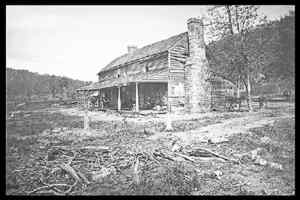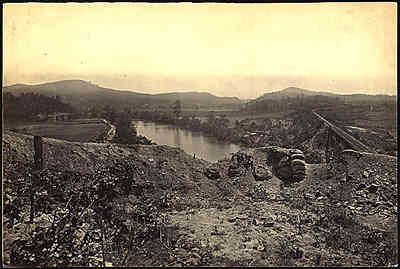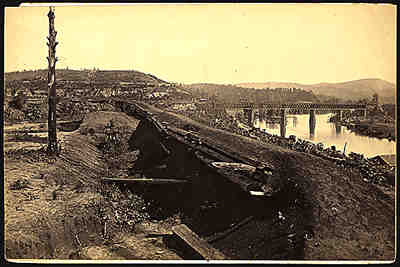Allatoona Area
In the Allatoona area, you will find the ruins of an important iron furnace
on the Etowah River, a visitor's center with Civil
War relics and exhibits, and the site of the famous Battle of Allatoona Pass.
During the Atlanta Campaign of 1864, Confederate Gen. Joseph Johnston retreated
from Cassville to the steep, 1,000-foot high Allatoona mountains, a virtually
impregnable natural fortress south of the Etowah River. The Western & Atlantic
Railroad passed through a 65- foot
deep cut in the mountains here. Sherman,
who was familiar with the terrain having surveyed it as a young man in 1844,
spent several days in Kingston contemplating his next move. He decided to sweep
his army around Johnston, travelling southeast on a network of primitive roads
to Dallas. If they moved quickly enough, he could move from here on to Atlanta,
perhaps unopposed by the Confederate Army.
foot
deep cut in the mountains here. Sherman,
who was familiar with the terrain having surveyed it as a young man in 1844,
spent several days in Kingston contemplating his next move. He decided to sweep
his army around Johnston, travelling southeast on a network of primitive roads
to Dallas. If they moved quickly enough, he could move from here on to Atlanta,
perhaps unopposed by the Confederate Army.
After the fall of Atlanta, Hood moved his battered army north to threaten Sherman's
supply line and draw him out of Atlanta. On Oct. 5, 1964, Hood's men attacked
two forts on either side of the mountain cut at Allatoona Pass in a bloody and
unsuccessful attempt to destroy the railroad here. The battle, with 30 percent
casualties (Confederate Gen. Samuel G. French had 70 officers killed or wounded),
was given extensive play in the Northern press. During the battle, Union Gen.
James M. Corse signalled Sherman for help, whose reported famous reply —
"Hold the Fort, I am Coming" — became a beloved hymn.
U.S. Army Corps of Engineers Visitor Center
Hwy. 294/Spur 20, Catersville 770-382-4700
This museum features Civil War exhibits, relics, artifacts, and the story and
memorabilia of Mark Cooper and his iron works. Outside the museum, walk to the
dam overlook and notice the white obelisk on the
right, called the Friendship Monument, erected by
Cooper to 38 friends who loaned him $100,000 during the financial panic of 1857
to keep him solvent. In 1860, he repaid his friends and erected a monument in
their honor. Markers nearby tell the story of Allatoona Pass.
- Exit 290 off I-75. Turn right off the exit ramp, and turn right on
Spur 20. Travel apx. 4 miles.
Cooper's Furnace Historic Site Day Use Area
River Rd., Cartersville
A beautiful park on the Etowah River south of Allatoona dam was the location
of Mark Cooper's Etowah Iron Works, a rolling mill,
flour mill, and factories for the production of guns, railroad iron, and tools,
stretching more than a mile down the river. More than 600 people worked in these
factories and lived in a town nearby called Etowah, which is now under Allatoona
Lake. Cooper sold his factories to the Confederacy in 1862, which needed iron
to fight the war. Found here are the remnants of an enormous stone furnace used
to create more than 20 tons of pig iron a week. Union Gen. John M. Schofield's
men destroyed the iron works shortly after C.S. Gen. Joseph Johnston abandoned
Cassville on May 22, 1864. After the war, there was an attempt to rebuild, but
the mill couldn't compete with the more modern northern mills. Notice the five
stone bridge supports in the Etowah River. A retreating
Johnston burned the bridge here, and it was never rebuilt. The "Great Locomotive
Chase" raced across these supports on April 12, 1862, and Union raider
Andrews in the General unwisely didn't destroy the bridge. Pursuing him
was Fuller on a handcar, which he abandoned here to borrow the Cooper Furnace
yard engine, Yonah, which motorized his pursuit to Kingston.
- U.S. 41 to River Road at the Etowah River. Follow signs.
Allatoona Pass Battlefield and Forts 
GA 397, Allatoona
Park near the dam and walk northwest on a closed dirt road, the old railroad
bed. As you enter the cut, marked by steep rock sides, notice the highest point,
approximately 65 feet from the roadbed. On top of the cut on the left is the
Star Fort or western redoubt, located on private property;
on the right, approximately 250 yards up, is the eastern redoubt, located on
U.S. Army Corps of Engineers property. The forts are
in a remarkable state of preservation. The eastern redoubt can be reached on
foot by a steep, unpaved road back near where you entered the cut. Across the
Emerson/Allatoona Road is the Clayton/Mooney House,
a private residence which was used as a headquarters prior to the battle and
as a hospital after the battle to treat some of the 1,500 casualties. The house
has bullet holes in the gables. Notice the marble gravestone
commemorating 21 unknown Confederates killed at Allatoona Pass and buried on
the grounds. Approximately 600 yards south of the house and across the railroad
tracks is the grave of "An Unknown Hero" protected by a wrought
iron fence.
Reader-Contributed Links to the Civil War in Georgia Book:
 foot
deep cut in the mountains here. Sherman,
who was familiar with the terrain having surveyed it as a young man in 1844,
spent several days in Kingston contemplating his next move. He decided to sweep
his army around Johnston, travelling southeast on a network of primitive roads
to Dallas. If they moved quickly enough, he could move from here on to Atlanta,
perhaps unopposed by the Confederate Army.
foot
deep cut in the mountains here. Sherman,
who was familiar with the terrain having surveyed it as a young man in 1844,
spent several days in Kingston contemplating his next move. He decided to sweep
his army around Johnston, travelling southeast on a network of primitive roads
to Dallas. If they moved quickly enough, he could move from here on to Atlanta,
perhaps unopposed by the Confederate Army.

